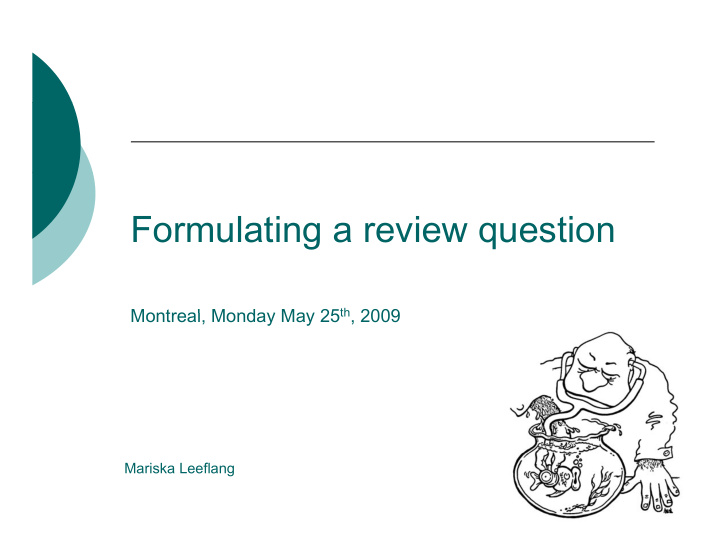



Formulating a review question g q Montreal Monday May 25 th 2009 Montreal, Monday May 25 th , 2009 Mariska Leeflang 1 Dr Mariska Leeflang Dept. Clinical Epidemiology, Biostatistics and Bioinformatics Academic Medical Center, University of Amsterdam Room J1B – 210 PO Box 227700 1100 DE Amsterdam m.m.leeflang@amc.uva.nl
E Examples of questions l f i Director of a diagnostic lab: “Should we purchase this device?” Insurance company: “Should we reimburse this test?” Insurance company: Should we reimburse this test? Guideline developers: “Should we recommend this test?” Head of a clinical department: “How should we use this test?” Patient: “Do I want to undergo this test?” Clinician: “What does this test result mean?” 2
How should test accuracy be used? To identify the best tests T id tif th b t t t To identify the best use of tests To identify the best use of tests Replacing In combination In sequence Probabilistic thinking Probabilistic thinking Combining with evidence of treatment effects in decision models ff i d i i d l 3
Q Question formulation ti f l ti Objective of a DTA SR can be To make comparisons between tests concerning their global accuracy To estimate the accuracy of a test operating h f at a particular threshold To understand why results of studies vary To understand why results of studies vary 4
5 Most questions are comparative ti ti t M
6 Most questions are comparative ti ti t M
Replacement If the new index test is being considered as If h i d i b i id d a replacement for the comparator test, we need to consider The accuracy of the new index test (new index test compared to ref std) The accuracy of the comparator test The accuracy of the comparator test (comparator test compared to ref std) 7
Add-on If the new index test is being considered as If th i d t t i b i id d additional to the comparator test, we need to consider: The rule which is being used to combine tests Either positive Both positive A scoring system The accuracy of the new index and comparator tests combined The accuracy of the comparator test The accuracy of the comparator test 8
Triage If the new index test is being considered as a test to If the new index test is being considered as a test to select patients for additional testing using the comparator test, we need to consider: The rule which is being used to define patients who need further testing New index test positive p New index test negative The accuracy of the triage strategy combining y g gy g test the new index and comparator tests The accuracy of the comparator test 9
Components of a question P atients, P resentation, P rior tests I ndex test, C omparator test P urpose: P urpose: comparative question comparative question alternative tests role of test(s) now and future role of test(s) now and future T arget disorder, R eference standard 10
Patients, Presentation, Prior Tests Presentation Presentation – indicates why the people in the indicates why the people in the study received the test, and indicates in what circumstances the results apply Sensitivity depends on the spectrum of disease in those with the target disorder important to know whether restricted by prior tests important to know whether restricted by prior tests, or referral status Specificity depends on the spectrum of alternative Specificity depends on the spectrum of alternative diseases in those without the target disorder important to know whether restricted by prior tests, or referral status 11
Index and comparator tests The index test is the “new” test we wish to Th i d i h “ ” i h evaluate. A review may consider and compare several index tests. p The comparator test is the alternative diagnostic management strategy which is standard practice and with which we would like to make comparisons p 12
Purposes of tests New index tests can be used in a variety N i d t t b d i i t of ways to improve diagnosis. REPLACEMENT They can be used to replace an existing test ADD ON ADD-ON They can be used in addition to an existing test TRI AGE They can be used to decide whether an existing test should be undertaken 13
Target disorders and reference standards Target disease is the condition we are trying to diagnose May be a pathologically defined condition May be a pathologically defined condition May simply be an indication for treatment Reference standard is the best way y available of identifying target condition Work-up or differential verification bias if tests used in reference diagnosis vary dependent on the result of the index test the result of the index test Incorporation bias if index test is part of the reference diagnosis 14
Background and objectives B k d d bj ti The most common problem we had in the Editorial Team, was that authors were not clea on the intended ole of the test and clear on the intended role of the test and the expected (or required) accuracy for that role. Authors forget to explain what they really want to know. 15
Exercise
Recommend
More recommend